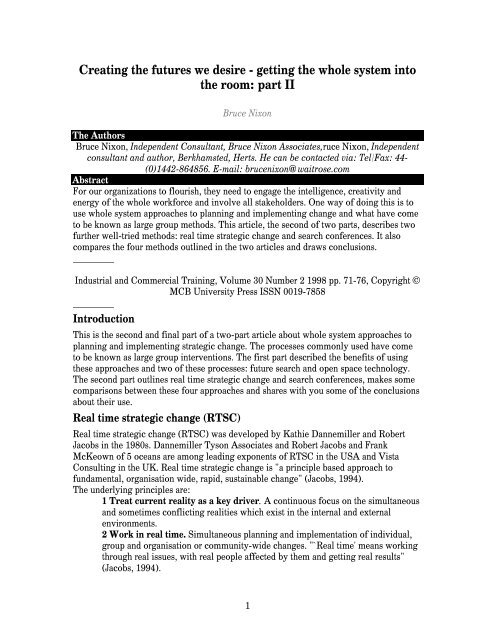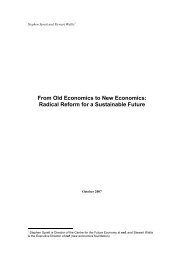Creating the futures we desire - getting the whole ... - Bruce Nixon
Creating the futures we desire - getting the whole ... - Bruce Nixon
Creating the futures we desire - getting the whole ... - Bruce Nixon
Create successful ePaper yourself
Turn your PDF publications into a flip-book with our unique Google optimized e-Paper software.
<strong>Creating</strong> <strong>the</strong> <strong>futures</strong> <strong>we</strong> <strong>desire</strong> - <strong>getting</strong> <strong>the</strong> <strong>whole</strong> system into<br />
<strong>the</strong> room: part II<br />
<strong>Bruce</strong> <strong>Nixon</strong><br />
The Authors<br />
<strong>Bruce</strong> <strong>Nixon</strong>, Independent Consultant, <strong>Bruce</strong> <strong>Nixon</strong> Associates,ruce <strong>Nixon</strong>, Independent<br />
consultant and author, Berkhamsted, Herts. He can be contacted via: Tel/Fax: 44-<br />
(0)1442-864856. E-mail: brucenixon@waitrose.com<br />
Abstract<br />
For our organizations to flourish, <strong>the</strong>y need to engage <strong>the</strong> intelligence, creativity and<br />
energy of <strong>the</strong> <strong>whole</strong> workforce and involve all stakeholders. One way of doing this is to<br />
use <strong>whole</strong> system approaches to planning and implementing change and what have come<br />
to be known as large group methods. This article, <strong>the</strong> second of two parts, describes two<br />
fur<strong>the</strong>r <strong>we</strong>ll-tried methods: real time strategic change and search conferences. It also<br />
compares <strong>the</strong> four methods outlined in <strong>the</strong> two articles and draws conclusions.<br />
Industrial and Commercial Training, Volume 30 Number 2 1998 pp. 71-76, Copyright ©<br />
MCB University Press ISSN 0019-7858<br />
Introduction<br />
This is <strong>the</strong> second and final part of a two-part article about <strong>whole</strong> system approaches to<br />
planning and implementing strategic change. The processes commonly used have come<br />
to be known as large group interventions. The first part described <strong>the</strong> benefits of using<br />
<strong>the</strong>se approaches and two of <strong>the</strong>se processes: future search and open space technology.<br />
The second part outlines real time strategic change and search conferences, makes some<br />
comparisons bet<strong>we</strong>en <strong>the</strong>se four approaches and shares with you some of <strong>the</strong> conclusions<br />
about <strong>the</strong>ir use.<br />
Real time strategic change (RTSC)<br />
Real time strategic change (RTSC) was developed by Kathie Dannemiller and Robert<br />
Jacobs in <strong>the</strong> 1980s. Dannemiller Tyson Associates and Robert Jacobs and Frank<br />
McKeown of 5 oceans are among leading exponents of RTSC in <strong>the</strong> USA and Vista<br />
Consulting in <strong>the</strong> UK. Real time strategic change is "a principle based approach to<br />
fundamental, organisation wide, rapid, sustainable change" (Jacobs, 1994).<br />
The underlying principles are:<br />
1 Treat current reality as a key driver. A continuous focus on <strong>the</strong> simultaneous<br />
and sometimes conflicting realities which exist in <strong>the</strong> internal and external<br />
environments.<br />
2 Work in real time. Simultaneous planning and implementation of individual,<br />
group and organisation or community-wide changes. "`Real time' means working<br />
through real issues, with real people affected by <strong>the</strong>m and <strong>getting</strong> real results"<br />
(Jacobs, 1994).<br />
1



